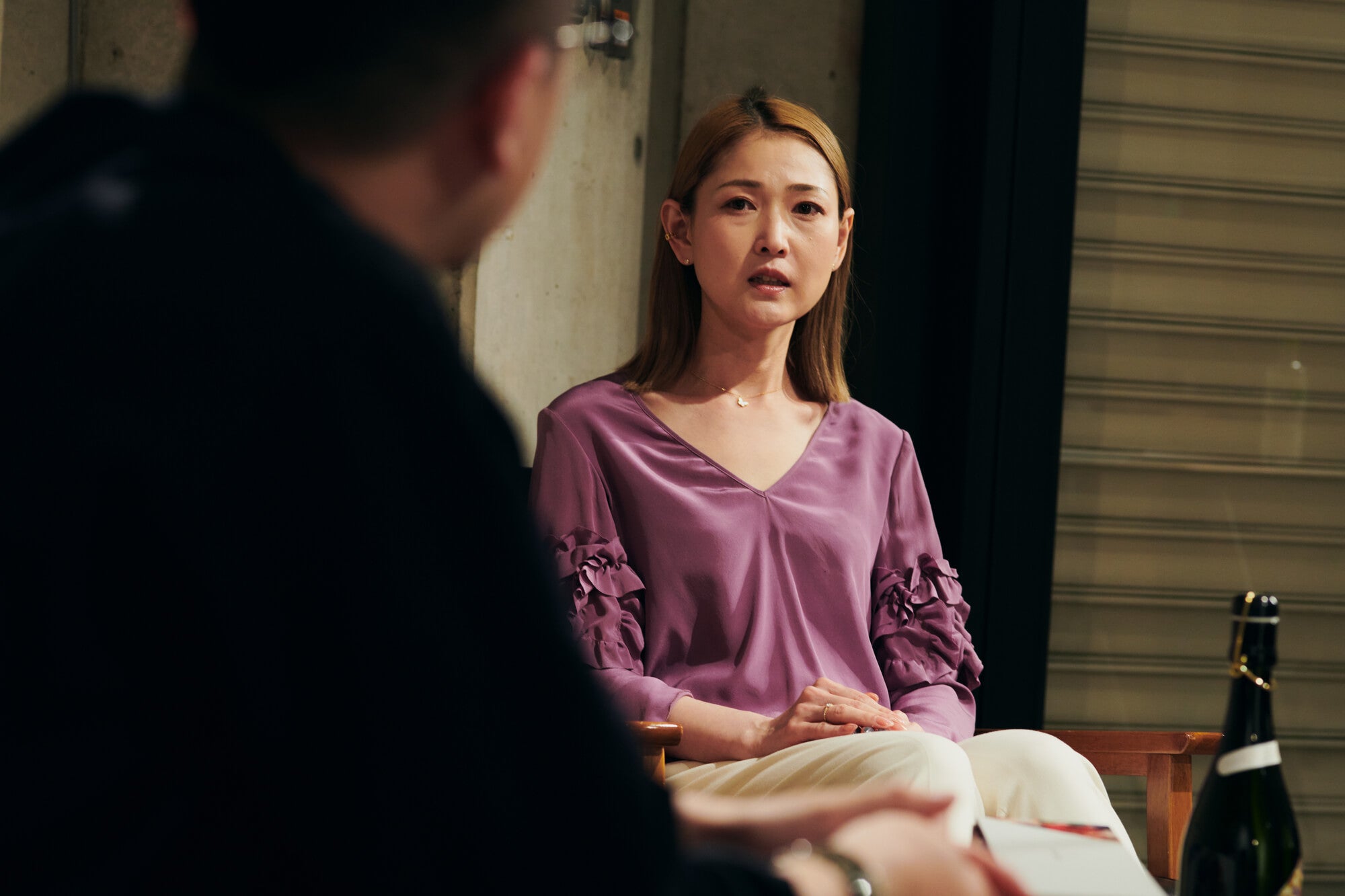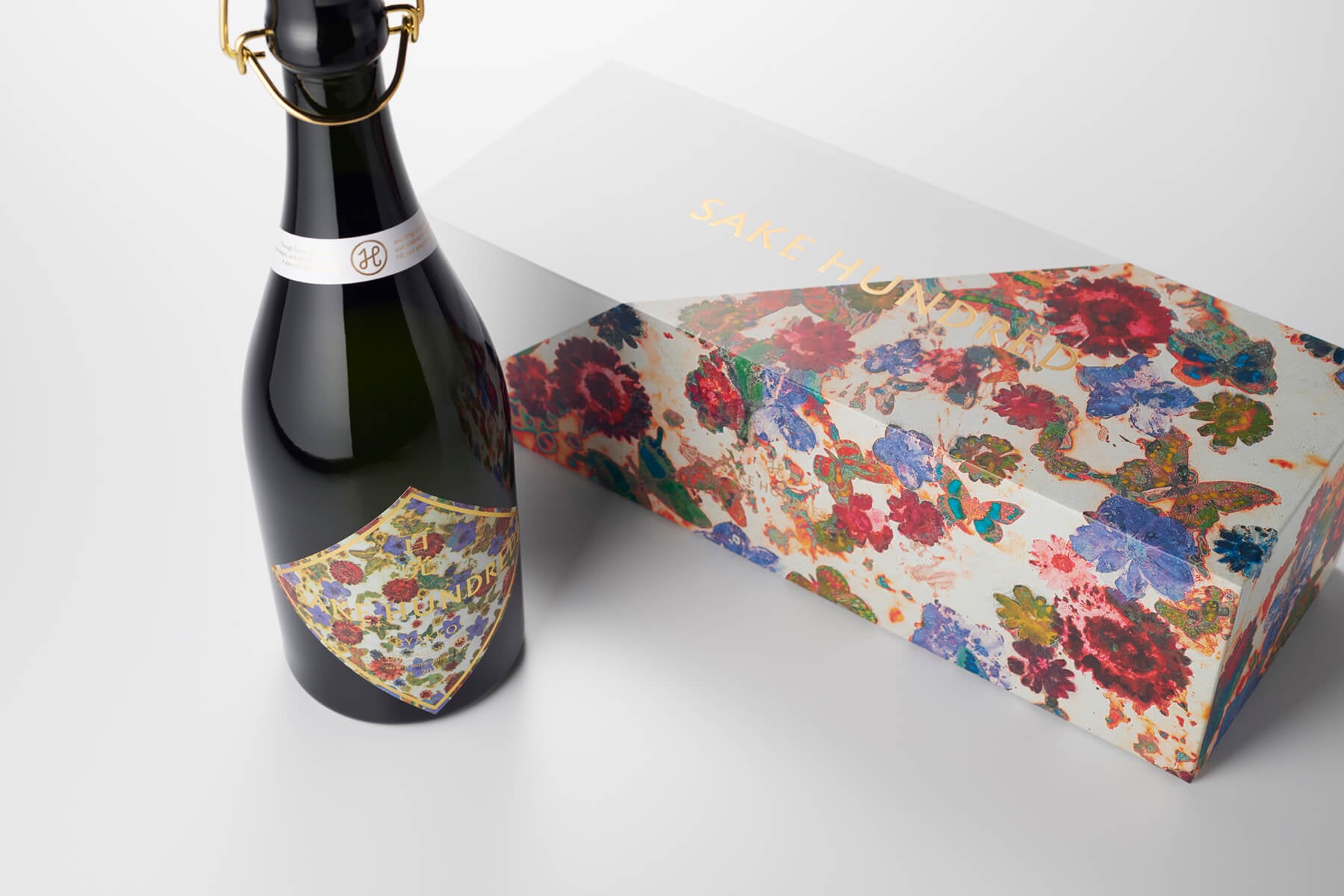An Enchanting Collaboration with Artist Hiroko Otake

On May 20, 2021, SAKE HUNDRED released a limited, special edition run of its flagship sake, Byakko, with an unmistakable and eye-catching label.
Festooned with butterflies and flowers-in-bloom arranged in a swirling, mesmerizing spiral, this limited label adorning just 420 Byakko bottles garnered the attention and praise of Japanese media and consumers alike, as much for its arresting beauty as for the reputed and accomplished artist behind the design, Hiroko Otake.
Otake is a known quantity both in her native Japan and, increasingly, abroad. Her modern takes on Japanese art, often created using traditional methods while evoking contemporary aesthetics, have graced the walls of the Vatican in Rome, galleries in New York and numerous collections in Japan.
Otake kindly took the time to speak in more detail with SAKE HUNDRED brand owner Ryuji Ikoma about the Byakko special edition collaboration. Their conversation is transcribed below:
The Seeds of Collaboration
Ikoma: SAKE HUNDRED’s brand ethos is to fill your heart, and color your life. While sake of the past has been somewhat utilitarian, aiming to satisfy solely in terms of flavor, our brand ethos expresses our intention to satisfy on a more emotional and experiential level.
For us, it’s more than just a drink in a glass. To provide satisfaction, an unforgettable experience, and a lasting impression, we have to convey an aura through various means. In other words, what’s “outside of the glass” is important, too.
To that end, as brand owner of SAKE HUNDRED, I’d been thinking about collaborations with artists for some time. It’s always seemed a great fit for our goals./p> 
Otake: The idea of a collaboration was actually brought to me by a mutual friend of ours, who’s been a supporter of SAKE HUNDRED for some time now. I thought it was a very fortuitous introduction. Were you open about your interest in art before?
Ikoma: No, in the past we never stated that directly. But, from our perspective, as a luxury brand, we knew fine art was in that same realm, and something we wanted to incorporate. But, we thought, if we’re going to commit to something, we want it to be original work.
Encountering the Works of Hiroko Otake
Ikoma: I believe the first time I saw a selection of your works, it was in an artist profile on a website. I was instantly fascinated. But I also saw your works on display at the Galerie Tamenaga in Ginza, Tokyo, and I would say that was the first time I was truly “confronted” with your works.
I vividly remember that sense of encountering something I’d never faced before. At the time, it was difficult to put the experience into words.
I felt I was confronting something that somehow surpassed anything I even had a metric for. It was like an impact, a wave of emotion and a sense of awe. The works instilled a kind of tension. I couldn’t take my eyes off them.

Otake: Art is a portal into, and a depiction of, a world that didn’t exist [before its creation], so I’m happy to hear you had a reaction like that. When people encounter something that is radically unfamiliar or seems “off” to them, their reaction is often one of disgust. So the art must have resonated with you, for you to take it in with such enthusiasm.
Ikoma: I have a personal rule when it comes to collaborations. I won’t go forward with it if it doesn’t move me. Regardless of a potential collaborator’s talents or experience, that’s a must.
Frankly, in part what I mean is, we have to check ourselves, so that [if we do a collaboration] it’s not just about profit. We pride ourselves on only putting the very best sake out into the world, so we’d only consider doing something if we really felt in our hearts that it was truly spectacular.
And, Ms. Otake, your work, of course, fits the bill and then some. I knew immediately after that encounter with your work at the gallery that we needed to collaborate with you.
A Shared Philosophy
Otake: I’m a sake fan, so just the idea of working with a sake brand made me very happy. On top of that, the more I learned about SAKE HUNDRED and its innovative approach, the more I related, and the more I noticed our shared philosophies.
For example, we both work in “Japanese tradition,” in a sense. That conjures a fixed image for most, for better or worse. [Working in that realm] can also be very restrictive, depending on your perspective. SAKE HUNDRED is trying something totally new in that framework, as am I.
In the case of traditional Japanese painting, people have an idea of what that entails. But, as with other types of work, be it oil, watercolor, copper prints, it’s just pigments on a canvas. When you add “Japan,” it’s almost as if you now have the added burden [of those expectations]. To an extent, perhaps that’s a good thing, but it shouldn’t decide how we approach our work.

Ikoma: I agree wholeheartedly. For our part, we of course aren’t making something that can’t be called sake, but we are striving to deliver something that’s never existed before. That’s reflected in the emotional value SAKE HUNDRED brings, and it’s reflected in our brand-based approach.
Still, our sake is made with Japanese rice and water, by Japanese breweries staffed by Japanese sake makers, so in a sense we do feel we have a responsibility to represent Japan.
Your artist profile has you as a “modern Japanese-style painter.” I get a sense of firm intent from that self-description.
Otake: I understand that industry rules dictate sake can only be sold if it’s clearly labeled “sake.” With Japanese paintings, on the other hand, if you call it modern art, you can sell it as modern art. For many, in fact, that’s easier to understand and may actually command more value. Contemporary art curators and gallery operators sometimes ask me, “Why do you call this Japanese painting?” But I think it’s a different thing to throw that categorization away entirely.
Understanding the Artist’s Intent

Otake: The theme for this collaboration work is “stability in change.”
It is the idea that you are your current self specifically because of constant changes, like [the chemistry concept of] dynamic equilibrium. Seasons repeat as spring, summer, winter, fall, year after year — yet each year’s seasons are different from the year before. In my work, I’m exploring this concept of change and stability existing concurrently, and the deeper truths that lie there.
This specific work, titled “Spiral –Flowers and Butterflies– Vol.8,” is inspired by SAKE HUNDRED’s Byakko. It features traditional Japanese painting techniques and evokes nature’s providence, the cyclical essence of things, and the connection between nature and humankind.
In the work, the eponymous flowers and butterflies are arranged in a spiral, in a reference to the spiral structures found in [natural objects like] plants and shells. I also consider the spiral to be a symbol of vitality and growth.
Flowers symbolize the cyclical nature of life, while the butterfly represents growth and change. The butterfly in the work is modeled after the common bluebottle — a species found in Yamagata, where Byakko is brewed.
The piece is made with a technique involving plastering silver foil onto the entire surface of the canvas and letting the silver vulcanize. The silver foil withering [during this process] is reminiscent of the withering of flowers, such that material and subject interweave.
I believe there may be parallels to the work’s themes in sake.

Ikoma: Certainly, you could say that the theme of stability in change is true of sake, too.
The idea of the seasons being the same year to year, yet always changing, also applies in sake brewing. Sake is made from autumn to winter, but the components that go into it — the rice, the environment, temperatures, even the technology — change year to year. In that sense, you can never make the exact same sake twice.
Even so, Byakko is always Byakko. The characteristics of its components may change slightly from year to year, but the flavors will always be Byakko. I think the theme of stability in change is found there. Amidst year to year variation, we’re still delivering the same constant value.
Byakko: Hiroko Otake Edition
Ikoma: When I first saw your design for our label, I was in awe. But it was accompanied by a feeling of, “What do I do now?” It was a feeling of admiration, that kind you might feel when something truly special is born into the world.
It cemented my belief that working with artists such as yourself was the right choice for SAKE HUNDRED. I felt it was something important to fulfill our brand ethos. Looking at your works, I pictured someone opening the sake box and being in awe, or taking in the breathtaking art on the label while drinking.
We talked many times during the planning stages for this collaboration, but I believe this may be the first time you’ve seen your work actually here on the bottle. What do you think?

Otake: I’m very pleased. It’s rare for me to be able to discuss details like coloring and the insertion of lettering as I create a work, so this feels very satisfying to me.
I believe prints and Japanese paintings are different things, but both are artistic works in their own right. So I wanted the packaging and the prints to work on their own regardless of reproducibility. I think that’s been achieved.
A Message to SAKE HUNDRED Fans
Ikoma: To the lucky ones who get a hold of this very special limited edition, I hope you are able to enjoy it to the fullest. I encourage you to “encounter” the work, as I did when I first saw Ms. Otake’s unforgettable pieces in the gallery. I hope this piece of Ms. Otake’s moves you as well. Of course, the experience is sure to be even better with a little alcohol to go with it.
Otake: I hope the experience is special. This and last year were “special years,” in their way, but I do hope that the experience with this bottle is the good kind of special. Alcohol is best enjoyed with others, so I hope this bottle will be enjoyed in good company.

このページをシェアする

